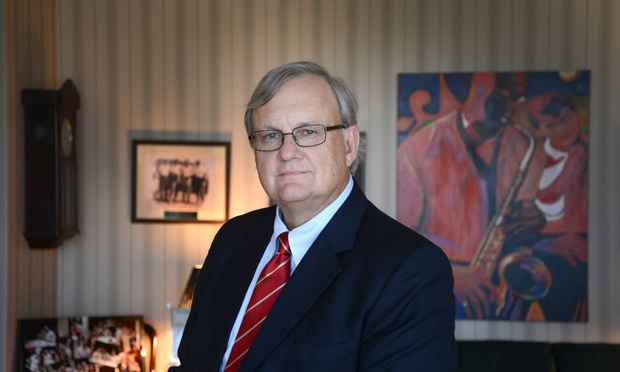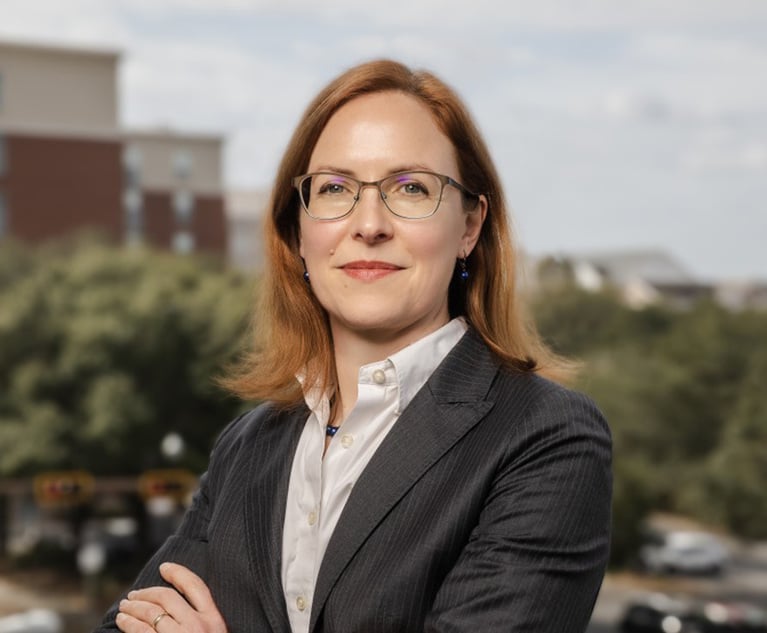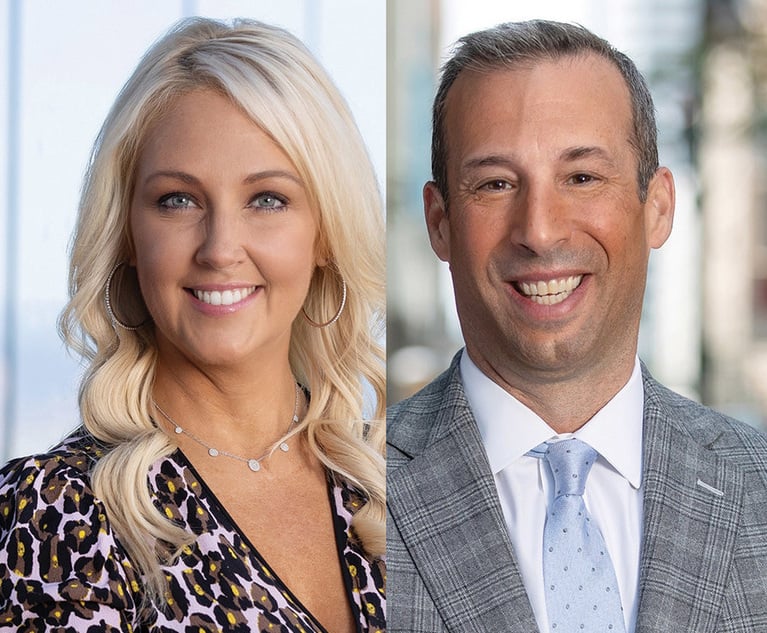Florida's Large Law Firms Expect Billing Rate Increases in 2020 While Smaller Firms Stay Put
The Daily Business Review's annual 2020 bankruptcy report found a nominal increase in average partner rates among Florida's regional firms, while the Am Law 200 is expecting another year of rate increases.
March 16, 2020 at 05:00 AM
5 minute read
 Robert C. Furr of Furr & Cohen. Photo: Melanie Bell
Robert C. Furr of Furr & Cohen. Photo: Melanie Bell
Florida's bankruptcy law firms reported little to no increases in rates last year, while the state's larger Am Law 200 firms all say they expect their own rates to rise.
The Daily Business Review gathered reported rates in bankruptcy filings to get a sense of whether billing rates are seeing increases or decreases in Florida. When compared to averages gathered on firm rates in 2018, the median rate for bankruptcy partners saw a small 1.2% increase among the firms who made both lists—a sign that among Florida's regional firms, rates stayed relatively flat.
The median rate among partners in the total sample of 71 Florida bankruptcy firms was $400. The median rate for associates was $319. The data does not account for the creditor representation taken on by larger firms such as Akerman, DLA Piper or White & Case as those rates are not public. Representing creditors is often more lucrative and many attorneys in the space charge upward of $1,000 per hour.
Furr & Cohen, which reported the eighth-highest average billing rate, saw its average billing rate drop by 7%. Co-founding partner Robert Furr said the slight decrease is incidental. Rates can vary year by year depending on whether or not he offered a blended fee and the staffing models he employs. Furr & Cohen reported an average partner billing rate of $500. In 2018, the firm's average partner rate was $538.
"The drop is just incidental," Furr said. "I haven't increased my partner rate in the last few years."
While Furr and other bankruptcy firms don't seem to have raised rates, all of Florida's large firms expect increases. Holland & Knight, Shutts & Bowen, Akerman, Greenberg Traurig, Greenspoon Marder and GrayRobinson all raised their rates by more than 3% last year and are expecting firmwide increases of more than 3% in 2020, according to ALM data.
Gretta Rusanow, head of Advisory Services at Citi Bank's Law Firm Group, said firms in the Southeast, which include several Florida firms, reported an average billing rate increase of 5.2% in 2019. That increase ranked fourth in the country, ahead of six other regions, including Washington, D.C., the Northeast and Northern California.
But Florida's rates have not yet grown to the levels charged by attorneys in other large markets such as New York, D.C. or Los Angeles. According to Canadian practice management company Clio, the average billing rate for Miami lawyers in 2017 was $297, the seventh highest among the 10 large metropolitan markets the company studied. Attorneys in New York City and Los Angeles on average charged the most, at $368 per hour and $346, respectively.
Veteran Florida legal recruiter Joe Ankus said rates in Florida will likely never reach the heights of other metro areas because of the nature of the state's economy: more local, smaller companies and fewer of the large Fortune 500 corporate clients that can stomach rates regularly approaching $1,000.
Around 40 Fortune 500 companies are headquartered in Florida, including NextEra Energy, Publix Super Markets and Office Depot. By comparison, New York is home to 95 Fortune 500 companies and California boasts 118.
"Miami has never considered itself in the same rate structure" as some of the more expensive markets, Ankus said. "It has nothing to do with the quality of the work, rather, many firms represent local businesses instead of national companies."
Rates can also differ within a single market. Large multinational firms such as DLA Piper and White & Case often charge rates exceeding those of locally founded Am Law 100 firms such as Greenberg Traurig, Akerman and Holland & Knight. Smaller firms such as Furr & Cohen, which aren't looking to grow at the same rate of the Am Law 200, can afford to keep their rates flat year after year.
The climbing rates of large firms leave an opportunity for smaller firms to pick up highly skilled attorneys. Many Big Law attorneys find themselves hamstrung by high rates that can shrink their client base, and smaller firms can capitalize on that.
Adam Foslid, a former litigation leader at Greenberg Traurig, said his rates have changed moderately since he joined boutique litigation firm Stumphauzer Foslid Sloman Ross & Kolaya last year. He said clients have appreciated the lower rates and fewer conflicts of boutique practice.
"I do think many clients have a preference, particularly in litigation, for smaller boutiques like mine," he said. "It's also opened doors to new opportunities and new clients I previously wouldn't be able to be exposed to."
Boutiques can also be more flexible on the financial arrangements with clients, said Luis Suarez, who recently left Boies Schiller Flexner to start the boutique firm Heise Suarez Melville alongside two other Boies Schiller partners. Many larger firms reported that less than 10% of their revenue was derived from alternative fee arrangements.
"Smaller firms can be more flexible on pricing and we can push the fixed fee arrangement," Suarez said. "And if they insist up an hourly we can be more competitive in the market than a big national firm."
Read more:
Lawyers Maintain an Edge in Rising Billing Rates, Study Finds
This content has been archived. It is available through our partners, LexisNexis® and Bloomberg Law.
To view this content, please continue to their sites.
Not a Lexis Subscriber?
Subscribe Now
Not a Bloomberg Law Subscriber?
Subscribe Now
NOT FOR REPRINT
© 2025 ALM Global, LLC, All Rights Reserved. Request academic re-use from www.copyright.com. All other uses, submit a request to [email protected]. For more information visit Asset & Logo Licensing.
You Might Like
View All
Essential Labor Shifts: Navigating Noncompetes, Workplace Politics and the AI Revolution

Adapting to AI and the Needs of Lawyers Will Be Key For Shutts & Bowen, Says Incoming Ft. Lauderdale Leader
8 minute read

Law Firms Mentioned
Trending Stories
- 1'Not the President's Personal Lawyer': Lawyers Share Concerns Over How AG Pick Bondi’s Loyalism to Trump May Impact DOJ
- 2US Judge OKs Partial Release of Ex-Special Counsel's Final Report in Election Case
- 3The Demise of Truth and Transparency in Federal Sentencing
- 4Former Phila. Solicitor Sozi Tulante Rejoins Dechert
- 5'I've Seen Terrible Things': Lawyer Predicts Spike in Hazing Suits
Who Got The Work
Michael G. Bongiorno, Andrew Scott Dulberg and Elizabeth E. Driscoll from Wilmer Cutler Pickering Hale and Dorr have stepped in to represent Symbotic Inc., an A.I.-enabled technology platform that focuses on increasing supply chain efficiency, and other defendants in a pending shareholder derivative lawsuit. The case, filed Oct. 2 in Massachusetts District Court by the Brown Law Firm on behalf of Stephen Austen, accuses certain officers and directors of misleading investors in regard to Symbotic's potential for margin growth by failing to disclose that the company was not equipped to timely deploy its systems or manage expenses through project delays. The case, assigned to U.S. District Judge Nathaniel M. Gorton, is 1:24-cv-12522, Austen v. Cohen et al.
Who Got The Work
Edmund Polubinski and Marie Killmond of Davis Polk & Wardwell have entered appearances for data platform software development company MongoDB and other defendants in a pending shareholder derivative lawsuit. The action, filed Oct. 7 in New York Southern District Court by the Brown Law Firm, accuses the company's directors and/or officers of falsely expressing confidence in the company’s restructuring of its sales incentive plan and downplaying the severity of decreases in its upfront commitments. The case is 1:24-cv-07594, Roy v. Ittycheria et al.
Who Got The Work
Amy O. Bruchs and Kurt F. Ellison of Michael Best & Friedrich have entered appearances for Epic Systems Corp. in a pending employment discrimination lawsuit. The suit was filed Sept. 7 in Wisconsin Western District Court by Levine Eisberner LLC and Siri & Glimstad on behalf of a project manager who claims that he was wrongfully terminated after applying for a religious exemption to the defendant's COVID-19 vaccine mandate. The case, assigned to U.S. Magistrate Judge Anita Marie Boor, is 3:24-cv-00630, Secker, Nathan v. Epic Systems Corporation.
Who Got The Work
David X. Sullivan, Thomas J. Finn and Gregory A. Hall from McCarter & English have entered appearances for Sunrun Installation Services in a pending civil rights lawsuit. The complaint was filed Sept. 4 in Connecticut District Court by attorney Robert M. Berke on behalf of former employee George Edward Steins, who was arrested and charged with employing an unregistered home improvement salesperson. The complaint alleges that had Sunrun informed the Connecticut Department of Consumer Protection that the plaintiff's employment had ended in 2017 and that he no longer held Sunrun's home improvement contractor license, he would not have been hit with charges, which were dismissed in May 2024. The case, assigned to U.S. District Judge Jeffrey A. Meyer, is 3:24-cv-01423, Steins v. Sunrun, Inc. et al.
Who Got The Work
Greenberg Traurig shareholder Joshua L. Raskin has entered an appearance for boohoo.com UK Ltd. in a pending patent infringement lawsuit. The suit, filed Sept. 3 in Texas Eastern District Court by Rozier Hardt McDonough on behalf of Alto Dynamics, asserts five patents related to an online shopping platform. The case, assigned to U.S. District Judge Rodney Gilstrap, is 2:24-cv-00719, Alto Dynamics, LLC v. boohoo.com UK Limited.
Featured Firms
Law Offices of Gary Martin Hays & Associates, P.C.
(470) 294-1674
Law Offices of Mark E. Salomone
(857) 444-6468
Smith & Hassler
(713) 739-1250






